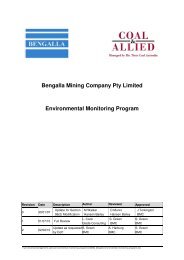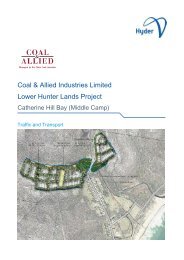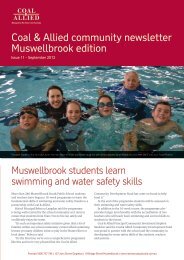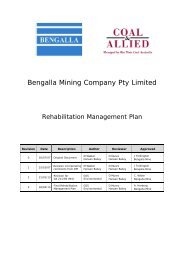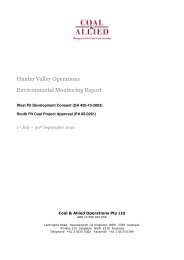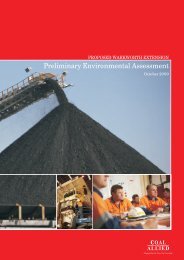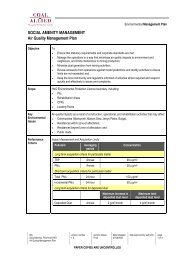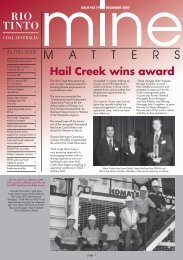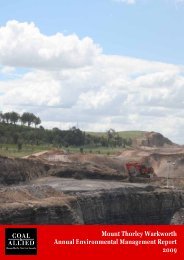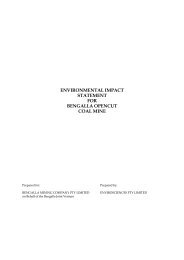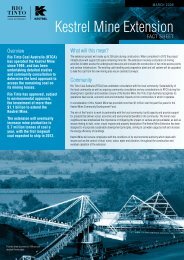HVO 2009 Annual Environmental Management Report - Final
HVO 2009 Annual Environmental Management Report - Final
HVO 2009 Annual Environmental Management Report - Final
Create successful ePaper yourself
Turn your PDF publications into a flip-book with our unique Google optimized e-Paper software.
Coal & Allied – Hunter Valley Operations<br />
3.2 AIR QUALITY<br />
3.2.1 <strong>Environmental</strong> <strong>Management</strong><br />
The objective of air quality management at <strong>HVO</strong> is to control the generation of dust from the site in order to<br />
minimise concentrations of atmospheric particulates in the surrounding area, particularly at the nearest<br />
privately owned residences. This includes deposited dust, Total Suspended Particulate matter (TSP) and<br />
Particulate Matter with an aerodynamic diameter less than 10 microns (PM 10 ).<br />
The <strong>HVO</strong> dust management programme aims to maintain dust (insoluble matter) deposition rates at adjoining<br />
residences below an annual average of 4.0g/m 2 /month. To monitor regional air quality, <strong>HVO</strong> operated and<br />
maintained a network of 10 depositional dust gauges on private land. Depositional dust was monitored<br />
monthly in accordance with AS 3580.10.1 (2003). These sites were analysed to determine the fallout rate of<br />
total mass, total insoluble matter, combustible matter and ash.<br />
The <strong>HVO</strong> air quality monitoring network is shown in Figure 19.<br />
Suspended particulate dust was measured in <strong>2009</strong> by a network of High Volume Air Samplers (HVAS). Seven<br />
of these were fitted with standard inlets to measure TSP and six were fitted with size-selective inlets to<br />
measure concentrations of PM 10 . A data share arrangement is in place for a TSP unit at Jerrys Plains School.<br />
In addition the network included six monitors to measure PM 10 concentrations in real time (refer to Appendix 7<br />
Real Time Air Quality Monitoring data).<br />
Each HVAS was run for 24 hours on a six-day cycle in accordance with DECCW requirements. When<br />
equipment malfunctioned eg power was interrupted, or problems occurred with filter papers etc, a make-up<br />
run was performed to ensure the required number of annual DECCW runs occurred. The HVAS machines<br />
were calibrated every two months.<br />
TSP monitors were sampled and analysed in accordance with AS 3580.9.3 (2003). The <strong>HVO</strong> dust<br />
management programme aimed to maintain total suspended solids below an annual average of 90μg/m 3 . No<br />
short term (24 hour) impact assessment criterion has been set for TSP concentrations.<br />
PM 10 monitors were sampled and analysed in accordance with AS 3580.9.6 (2003). The <strong>HVO</strong> dust<br />
management programme aimed to maintain particulate matter below the short term (24 hour) value of<br />
50μg/m 3 and an annual average of 30μg/m 3 .<br />
The dust monitoring network illustrated in Figure 19 provided site management with monitoring data to assist<br />
in the management of air quality. Detailed air quality monitoring results for the reporting period are presented<br />
in Appendix 6 and are discussed below.<br />
Dust is controlled and managed at <strong>HVO</strong> in accordance with Coal & Allied EMS <strong>Environmental</strong> Procedure 8.1<br />
Dust <strong>Management</strong> CHPP and <strong>Environmental</strong> Procedure 8.2 Dust <strong>Management</strong> – Mobile Equipment. The main<br />
method of dust suppression used on site is spraying mine water on active areas having the potential to create<br />
dust. Typical control procedures used at <strong>HVO</strong> were:<br />
<br />
<br />
<br />
<br />
<br />
<br />
<br />
<br />
The use of water carts to deliver water to active mining areas, active spoil emplacement areas, coal<br />
stockpiles, haul roads and other areas that are subject to frequent vehicle movements;<br />
Dust control systems are maintained in good working order;<br />
Coal dump hoppers are fitted with automatically activated sprays that operate whenever trucks dump into<br />
the hoppers;<br />
Topsoil stripping is confined to periods when there is sufficient moisture contained in the soil to minimise<br />
dust generation, where practical;<br />
Correct operation of equipment to minimise dust generation;<br />
Mine spoil is rehabilitated as soon as practicable after mining to reduce exposed areas;<br />
Operations are restricted during windy and dry weather; and<br />
Conveyor covers (partially and fully enclosed).<br />
AEMR <strong>2009</strong> 55



